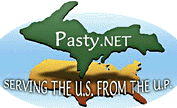By Bob Jewell, Farmington Hills (Rjewell) on Saturday, May 5, 2007 - 07:51 pm:
Wild turkeys have spread overe much of the state but the DNR does not expect them to spread to the easter U.P.
Don't Shoot!
DNR: Local Turkeys Not Wild Birds
By Amy Polk
These turkeys, wading in the snow on the shoulder of Mackinac Trail, north of St. Ignace, resemble wild birds, but reportedly are part of domestic stocks that have been released or wandered away from their pens.
Turkeys are reported crossing local highways, and although they resemble their wild relatives, the Department of Natural Resources says they are most likely pen-raised birds released by a well-meaning farmer or sportsman, or strays from a farm.
"The DNR has supported expanding wild turkeys' range, but the Eastern Upper Peninsula apparently doesn't have suitable habitat for the bird to survive," noted Erynn Call, a wildlife biologist at the DNR field office in Sault Ste. Marie.
In 1993 the Department of Natural Resources (DNR) selected 25 wild turkeys for release in the Eastern Upper Peninsula. They were disease free and chosen for their hardiness to survive cold weather. They were released on Hiawatha Sportsmen's Club property near Engadine, but none of them survived, she said, and it was the last attempt by the DNR to introduce turkeys to the area.
The turkey is one of the largest birds in North America, and was once prolific in southern Michigan. When the forests were cleared at the turn of the last century, they virtually disappeared from the state. The DNR suspects unregulated hunting may have also played a role in wiping the bird out. The last recorded native turkey kill was in 1897, in Van Buren County.
Michigan wildlife biologists led an effort to reintroduce turkeys to Michigan in the 1950s. Wild birds were first released in southwestern Michigan, and subsequently in the northern Lower Peninsula and Upper Peninsula. Helped by maturing forest regrowth as Michigan's woods began to recover from heavy lumbering, turkeys reestablished significant populations in the northern Lower Peninsula, with pockets of smaller populations further south. In the Upper Peninsula, the largest wild populations are found in the southwestern part of the peninsula, in Delta, Dickinson, and Menominee counties.
Turkeys seem to prefer a mix of hardwood forest, Ms. Call said, particularly white and red oak stands, with some conifers and open field areas. Acorns are key to their survival, she said. They also consume leftover grains on harvested fields, like corn, sorghum, buckwheat, and soybeans. Turkeys, she noted, need a lot of carbohydrates to survive Michigan winters.
The Eastern Upper Peninsula does not have much of the habitat turkeys like, she said, which is probably why they have not reestablished successfully here. The birds that have been seen around Lakeside Road in Cedarville, Goetzville, Ponchartrain Shores, and on Mackinac Trail are most likely pen-raised or descendent from domestic birds, Ms. Call said. The penraised turkeys are nearly indistinguishable from wild birds, she said, and have the same characteristics. Wild birds have a somewhat slimmer head, with less skin under the chin.
It is now turkey breeding season, so males have been seen sporting the typical bright red head that changes color from red, to blue, to white. Males can also be observed now puffing out their feathers, spreading their tails, and dragging their wings as a courtship display. Turkey hens lay eggs in April, and eggs hatch around late June. The birds spend the rest of the year foraging, first for insects, then for nuts and fruits in the fall and winter months. They do not migrate, and must find suitable cover and feed to survive the winter.
Ms. Call speculates that local turkeys have most likely survived Eastern Upper Peninsula winters through artificial feeding by residents. Food can be found at farms or bird feeders. The DNR does not recommend artificial turkey feeding because the birds can spread disease to native and wild birds.
Turkey hunting is not allowed in the Eastern Upper Peninsula counties of Chippewa, Luce, and Mackinac.
People can hunt turkeys in designated parts of the central and western Upper Peninsula, and in nearly every county of the northern Lower Peninsula. Hunters must apply for spring or fall turkey hunting permits through a drawing process. Information about the application process is at the DNR's Web site under the hunting section.
By Greta Jones (Urbanescapees) on Sunday, May 6, 2007 - 10:22 am:
This could be the pair I saw in our yard on Thursday. Nice shot, Neil.





